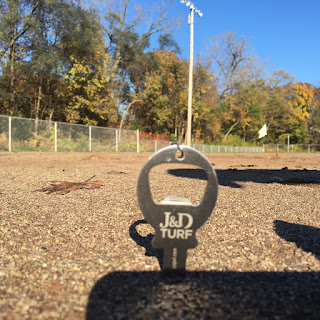Spring
is just around the corner and with spring comes the arrival of
crabgrass control applications. The use of crabgrass pre-emergent
herbicides on sports turf must be carefully considered. Will I need to
overseed in the spring? Will I need to overseed the entire field or just
certain areas? Is the option to overseed more important than crabgrass
pressure later in the summer? All good questions, let’s work to an
answer.
HOW DO THE PRODUCTS WORK?
First of all, let’s take a look at how crabgrass pre-emergent products work.
Research
has shown that applications should be made when average daily soil
temperatures reach 57 to 64 degrees at a 1 inch depth. Following
application, a barrier will form that will inhibit crabgrass seedling
emergence.
Keep
in mind, the barrier will also inhibit grass seed emergence! How do you
know when you should apply if you do not want to check daily soil
temperatures? Simply go to the Growing Degree Day Tracker. (GDD Tracker) The tracker is a joint effort from Michigan State Turfgrass, Purdue Turfgrass and the Midwest Regional Turf Foundation (MRTF).
The GDD Tracker will provide updates on when the product needs to be
applied. Typically, pre-emergent products need to be applied prior to
April 1 in the southern third of the state of Indiana, by April 15 in
the middle third, and by April 30 in the northern third.
WHAT ARE THE BEST PRE-EMERGENT OPTIONS?
So,
the plan is to apply a crabgrass pre-emergent herbicide product. The
timing has been determined. Now the question is, “What product should I
apply?”
To keep it simple consider two products:
1. Dithiopyr (Dimension)
2. Prodiamine (Barricade)
Advanced Turf Solutions offers both products. Please call for options as the products are available in both granular and liquid formulations.
I MISSED MY APPLICATION. CAN POST-EMERGENT APPLICATIONS BE MADE?
Yes.
Careful consideration should be made to select the best products as
some pre-emergent products (Prodiamine) will not be effective. My
recommendation for early season (April through early May) is Dithiopyr
as the product is effective on crabgrass in the one to three leaf stage.
Liquid applications are recommended.
TIP – If
dormant seeding was used on the playing surface, a late spring
application of Dithiopyr (after the turfgrass seed has germinated) will
control young crabgrass while also creating a barrier for any crabgrass
seed that has not germinated. Other post-emergent products include
Fenoxyprop and Quinclorac (Quin Pro). As always, please check product
labels for rates.
TIPS TO REDUCE CRABGRASS PRESSURE:
- Maintain a dense turf stand
- Irrigate turfgrass with deep and infrequent cycles
- More than half of your total nitrogen should be applied from September through November
- When possible, water in pre-emergent products
THINGS TO CONSIDER BEFORE A PRE-EMERGENT HERBICIDE APPLICATION:
- Do I need to overseed?
- Should I avoid high traffic areas where I know I will be overseeding?
- Would I rather overseed or control crabgrass?












